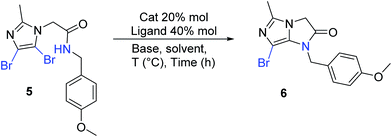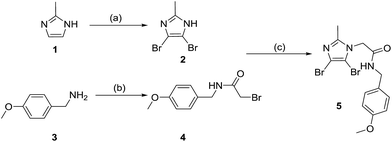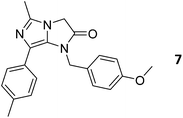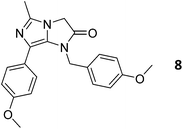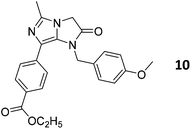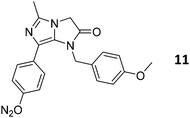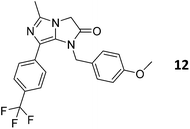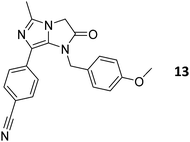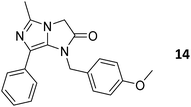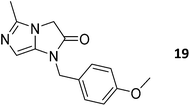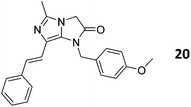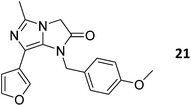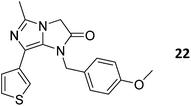A new synthetic approach to the imidazo[1,5-a]imidazole-2-one scaffold and effective functionalization through Suzuki–Miyaura cross coupling reactions†
M. Loubidiab,
C. Pillardc,
A. El Hakmaouib,
P. Bernardc,
M. Akssira*b and
G. Guillaumet*a
aInstitut de Chimie Organique et Analytique, Université d’Orléans, UMR CNRS 7311, 45067 Orléans Cedex, France. E-mail: gerald.guillaumet@univ-orleans.fr
bEquipe de Chimie Bioorganique & Analytique, URAC 22 Université Hassan II Mohammedia-Casablanca, BP 146, 28800 Mohammedia, Morocco
cGreenpharma S.A.S., 3, allée du Titane, 45100, Orleans, France
First published on 8th January 2016
Abstract
We report herein a synthetic pathway to new 7-bromo-1-(4-methoxybenzyl)-5-methyl-imidazo[1,5-a]imidazole-2-one. The synthetic potential of this scaffold was demonstrated by displacing bromine by Suzuki–Miyaura cross-coupling reactions. A large panel of boronic acids (aryl, heteroaryl or vinyl) were easily introduced, giving access to a broad and diversified library of 1-(4-methoxybenzyl)-5-methyl-7-(substituted)-imidazo[1,5-a]imidazole-2-ones.
Introduction
In recent years, nitrogen-bridgehead heterocycles have received considerable attention from many different research teams in organic synthesis due to their interesting biological activities.1 In addition, this family of compounds possesses a high reactivity for functionalization with new coupling methods.Among nitrogen cycles, 5–5 bicycles have received particular attention due to their biologically interesting properties exploited in drug manufacture.2 The imidazo[1,5-a]imidazole is a nitrogenous heterocycle with significant interest in drug synthesis and functionalization. It was reported that its oxoanalog imidazo[1,5-a]imidazolinone has also proved to be a structurally pertinent skeleton for the development of biologically active and pharmaceutically relevant compounds.3
Current strategies for preparing imidazo[1,5-a]imidazolinone derivatives generally consist in building the 5–5 fused ring with the desired substituents in appropriate position.4 A careful literature survey revealed that no method for the functionalization of the heterocyclic moiety has yet been described. In this context, the overall goal of our research was to develop an efficient synthesis of imidazo[1,5-a]imidazole-2-one synthon that permits its subsequent functionalization, thereby enabling molecular diversity.
Based on the interest of our group in the synthesis of nitrogen-based heterocycles,5 we disclose herein the access to a library of original 5-methyl-7-(hetero)arylated-imidazo[1,5-a]imidazole-2-one derivatives. Our synthetic strategy is based on an efficient four-step synthesis of the bicycle followed by palladium catalyzed Suzuki–Miyaura cross-coupling.6 To the best of our knowledge, no example of palladium cross-coupling reaction on the imidazo[1,5-a]imidazolinone core has yet been reported.
Results and discussion
The required starting compound for the Suzuki–Miyaura reaction was synthesized in four steps from the commercially available 2-methylimidazole 1. After dibromation of 1,7 compound 2 was engaged in a N-alkylation with 2-bromo-N-(4-methoxybenzyl)acetamide 4 (obtained from a reaction between 4-methoxybenzylamine 3 and bromoacetyl bromide).8The condensation reaction between 2 and 4 was performed in the presence of sodium hydride in dry tetrahydrofuran and afforded amide 5 in 90% yield (Scheme 1).9
Product 5 was engaged in an intramolecular cyclization. First, a Buchwald-type cyclization using palladium acetate, xantphos as ligand and cesium carbonate as base was tested10 (Table 1, entries 1–4) but low conversion was observed. Replacing the catalyst by copper iodide11 resulted in better conversion (Table 1, entry 5). The use of K3PO4 as base considerably improved the conversion rate to 89% in toluene and to 80% in N,N-dimethylformamide (Table 1, entries 6 and 7). The addition of a ligand such as N,N′-dimethylethylenediamine12 did not improved the yield (Table 1, entries 8 and 9). We also carried out the reaction in different solvents (Table 1, entries 10–12). Finally, a total conversion was obtained in toluene at 160 °C during 4 hours (Table 1, entry 13). We also found that the heating system has a significant influence, since heating in a sealed tube for 20 hours also led to a conversion rate of 100%, and a yield after column chromatography of 81% (Table 1, entry 15). To complete the optimization, we evaluated the impact of the amount of base and CuI. Decreasing the quantity of K3PO4 to 2 equivalents did not maintain a coupling efficiency (Table 1, entry 16). On the other hand, the catalyst loading could be reduced to 10 mol% of CuI without impacting the yield of the reaction (Table 1, entry 17). However 5 mol% involved a partial conversion rate and a low yield (Table 1, entry 18).
| Entry | Catalyst | Ligand | Base | Solvent | Time (h) | T (°C) | Heating system | Conv.a | Yieldb |
|---|---|---|---|---|---|---|---|---|---|
| a 1H NMR ratio based on the integration of CH3.b Yield of isolated product after column chromatography.c Degradation of the reaction mixture.d With 10 mol% of copper iodide (CuI).e With 5 mol% of copper iodide (CuI).f 100% of starting material 5 is recovered. | |||||||||
| 1 | Pd(OAc)2 | Xantphos | Cs2CO3 (2 eq.) | 1,4-Dioxane | 4 | 150 °C | MW | 0 | —c |
| 2 | Pd(OAc)2 | Xantphos | Cs2CO3 (2 eq.) | t-BuOH | 4 | 150 °C | MW | 0 | —c |
| 3 | Pd(OAc)2 | Xantphos | Cs2CO3 (2 eq.) | Toluene | 4 | 150 °C | MW | 38 | 29 |
| 4 | Pd(OAc)2 | Xantphos | Cs2CO3 (4 eq.) | Toluene | 4 | 150 °C | MW | 46 | 37 |
| 5 | CuI | — | Cs2CO3 (4 eq.) | Toluene | 4 | 150 °C | MW | 72 | 55 |
| 6 | CuI | — | K3PO4 (4 eq.) | Toluene | 4 | 150 °C | MW | 89 | 74 |
| 7 | CuI | — | K3PO4 (4 eq.) | DMF | 4 | 150 °C | MW | 80 | 58 |
| 8 | CuI | DMEDA | K3PO4 (4 eq.) | DMF | 2 | 150 °C | MW | 55 | 42 |
| 9 | CuI | DMEDA | Cs2CO3 (4 eq.) | DMF | 2 | 150 °C | MW | 28 | 19 |
| 10 | CuI | — | K3PO4 (4 eq.) | 1,4-Dioxane | 4 | 150 °C | MW | 0 | —c |
| 11 | CuI | — | K3PO4 (4 eq.) | Toluene/DMF (4/1) | 4 | 150 °C | MW | 57 | 44 |
| 12 | CuI | — | K3PO4 (4 eq.) | Toluene/ethanol (4/1) | 4 | 150 °C | MW | 25 | 17 |
| 13 | CuI | — | K3PO4 (4 eq.) | Toluene | 4 | 160 °C | MW | 100 | 80 |
| 14 | CuI | — | K3PO4 (4 eq.) | Toluene | 16 | 150 °C | Sealed tube | 87 | 68 |
| 15 | CuI | — | K3PO4 (4 eq.) | Toluene | 20 | 150 °C | Sealed tube | 100 | 81 |
| 16 | CuI | — | K3PO4 (2 eq.) | Toluene | 20 | 150 °C | Sealed tube | 57 | 46 |
| 17 | CuId | — | K3PO4 (4 eq.) | Toluene | 20 | 150°C | Sealed tube | 100 | 80 |
| 18 | CuIe | — | K3PO4 (4 eq.) | Toluene | 20 | 150 °C | Sealed tube | 78 | 64 |
| 19 | — | — | K3PO4 (4 eq.) | Toluene | 4 | 160 °C | MW | 0 | —f |
These functionalizable intermediate 6 open the way to design a chemical library of imidazo[1,5-a]imidazolinone derivatives from the bromide in position 7.
Initial optimization trials of the Suzuki–Miyaura cross coupling reaction were performed on the imidazole skeleton 6 synthesized previously using p-tolylboronic acid. As a model, we began with the investigation using different palladium sources, (palladium(II) acetate, [1,1 bis(diphenylphosphino) ferrocene]dichloropalladium) complexed with dichloromethane Pd(dppf)Cl2·CH2Cl2, or bis(dibenzylideneacetone)palladium(0) as the catalyst, potassium carbonate as the base and a mixture of 1,4-dioxane/ethanol 2/1 as solvent. The coupling product 7 was obtained in the three tests with acceptable yields but with only a partial conversion rate (Table 2, entries 1–3).
| Entry | Catalyst | Ligand | Solvent | Time [min] | Heating system | Conv.a [%] | Yieldb [%] |
|---|---|---|---|---|---|---|---|
| a 1H NMR ratio based on the integration of CH3 or OCH3.b Yield of isolated product after column chromatography. | |||||||
| 1 | Pd(OAc)2 | Xantphos | 1,4-Dioxane/EtOH (2/1) | 180 | Reflux | 82 | 61 |
| 2 | Pd(dppf)Cl2·CH2Cl2 | — | 1,4-Dioxane/EtOH (2/1) | 90 | Reflux | 91 | 72 |
| 3 | Pd2(dba)3 | — | 1,4-Dioxane/EtOH (2/1) | 90 | Reflux | 71 | 44 |
| 4 | Pd(dppf)Cl2·CH2Cl2 | — | 1,4-Dioxane | 90 | Reflux | 52 | 21 |
| 5 | Pd(OAc)2 | Xantphos | Toluene/EtOH (2/1) | 180 | Reflux | 90 | 67 |
| 6 | Pd(dppf)Cl2·CH2Cl2 | — | Toluene/EtOH (2/1) | 90 | Reflux | 100 | 88 |
| 7 | Pd2(dba)3 | — | Toluene/EtOH (2/1) | 90 | Reflux | 79 | 51 |
| 8 | Pd(dppf)Cl2·CH2Cl2 | — | Toluene/EtOH (2/1) | 20 | MW, 130 °C | 100 | 73 |
Without ethanol, even after 90 minutes of heating, only 52% of conversion was achieved (Table 2, entry 4), showing that a protic solvent is essential in this coupling process.
Replacing 1,4-dioxane by toluene led to a significant increase in conversion rate (Table 2, entries 5–7). The best conditions were found with a mixture of toluene/ethanol 2/1 as solvent. We next focused our attention on the influence of the catalyst. The use of palladium(0) instead a palladium(II) (i.e. Pd2dba3 in replacement of Pd(OAc)2 or Pd(dppf)Cl2·CH2Cl2), the yield significantly decreased (Table 2, entries 5–7). Finally, replacing conventional thermal heating by microwave irradiation produced no real improvement in terms of yield and time (Table 2, entry 8).
Optimum conditions were found to be boronic acid (1.5 equiv.), Pd(dppf)Cl2·CH2Cl2 (0.10 equiv.), K2CO3 (1.5 equiv.) in a mixture of toluene/ethanol 2/1, refluxing for a short time of 1.5 hour.
To explore the scope of the methodology, we applied these selected conditions using different boronic acids. Gratifyingly, the optimized conditions proved to be efficient with boronic acids containing a large variety of functional groups. More precisely, para-substituted phenylboronic acids bearing electron-rich (CH3, OCH3) or electron-poor (COOEt, NO2, CF3, CN) groups led to 7-aryl-1H-imidazo[1,5-a]imidazole-2-ones in good yields (Table 3, entries 1–7). Notably, meta-substitution did not disfavor the cross-coupling reaction. In fact, derivatives 15–18 were obtained in satisfactory yields (Table 3, entries 9–12). However, using ortho-substituted phenylboronic acids provided only the dehalogenation product 19 (Table 3, entries 13–15). Steric hindrance could explain this result.
Finally, heterocycles such as 3-furane and 3-thiophene were introduced with moderate yields of 46% and 65% respectively (Table 3, entries 17 and 18). The strategy was also compatible with vinylboronic acid, since styryl derivative 20 was obtained in 67% yield (entry 16).
Conclusion
In conclusion, we have reported here a new method to access the imidazo[1,5-a]imidazole-2-one core. We then developed the first C-7 pallado-catalyzed functionalization of this bicycle by Suzuki–Miyaura cross-coupling reactions. The methodology described is original and effective. Good yields were obtained for a wide range of (hetero)aryl boronic acids with both electron-poor and electron-rich substituents, giving access to a library of new 7-substituted-1-(4-methoxybenzyl)-5-methyl-1H-imidazo[1,5-a]imidazole-2-ones.Experimental
General
All reagents were purchased from commercial suppliers and were used without further purification. The reactions were monitored by thin-layer chromatography (TLC) analysis by using silica gel (60 F254) plates. Compounds were visualized by UV irradiation at 256 or 365 nm. Flash column chromatography was performed on silica gel 60 (230–400 mesh, 0.040–0.063 mm). Melting points (mp [°C]) were taken on samples in open capillary tubes. Infrared spectra of compounds were recorded with a Thermo Scientific Nicolet iS10 instrument. 1H and 13C NMR spectra were recorded with a Bruker spectrometer at 250 MHz (13C, 61.5 MHz) or 400 MHz (13C, 101 MHz). Chemical shifts are given in parts per million (ppm) from tetramethylsilane (TMS) as internal standard in CDCl3, and the residual peak of DMSO in [D6]DMSO. The following abbreviations are used for the 1H NMR spectra multiplicities: br. s: broad singlet, s: singlet, d: doublet, t: triplet, q: quartet, qt: quintuplet, m: multiplet. Coupling constants (J) are reported in Hertz [Hz]. CIV is the abbreviation for quaternary carbon atoms. High-resolution mass spectra (HRMS) were performed with a Maxis Bruker 4 G instrument.White solid (9.06 g, 62%); mp 235–237 °C (ref. 13, 239–240 °C), IR (neat, cm−1): 1397, 1556, 3122, 3216, 3490; 1H NMR (400 MHz, DMSO-d6): δ 2.23 (s, 3H, CH3); 13C NMR (101 MHz, DMSO-d6): δ 14.3, 105.95 (2C), 146.0 (CIV); HRMS (ESI): calcd for C4H5Br2N2 238.88140 [M + H]+, 260.86334 [M + Na]+ found 238.88134 [M + H]+ 260.86327 [M + Na]+.
White solid (8.9 g, 95%); mp: 119–121 °C (ref. 14, 120–121 °C); IR (neat, cm−1): 818, 1030, 1179, 1212, 1243, 1512, 1645, 3280; 1H NMR (400 MHz, CDCl3): δ 3.81 (s, 3H), 3.92 (s, 2H), 4.41 (d, J = 5.7 Hz, 2H), 6.89 (d, J = 8.5 Hz, 2H), 6.70 (br. s, 1H), 7.22 (d, J = 8.5 Hz, 2H); 13C NMR (101 MHz, DMSO-d6): δ 29.5, 42.0, 55.1, 113.8 (2C), 128.7 (2C), 130.1, 158.3, 165.9; HRMS (ESI): calcd for C10H13BrNO2 258.01242 [M + H]+ 279.99436 [M + Na]+ found 258.01227 [M + H]+ 279.9944 [M + Na]+.
White solid (9.90 g, 90%); mp: 132–134 °C; IR (neat, cm−1): 700, 846, 1017, 1245, 1462, 1504, 1600; 1H NMR (250 MHz, DMSO-d6): δ 2.28 (s, 3H), 3.73 (s, 3H), 4.25 (d, J = 5.7 Hz, 2H), 4.69 (s, 2H), 6.90 (d, J = 8.7 Hz, 2H), 7.20 (d, J = 8.7 Hz, 2H), 8.73 (s, 1H); 13C NMR (101 MHz, DMSO-d6): δ 13.8, 42.1, 48.1, 55.3, 103.3 (2C), 114.0 (2C), 128.8 (2C), 130.8, 147.3, 158.5, 165.6; HRMS (ESI): calcd for C14H16Br2N3O2 415.9606 [M + H]+ found 415.9604 [M + 1]+.
![[thin space (1/6-em)]](https://www.rsc.org/images/entities/char_2009.gif) :
:![[thin space (1/6-em)]](https://www.rsc.org/images/entities/char_2009.gif) 30) to provide the desired product 6.
30) to provide the desired product 6.White solid (328 mg, 81%); mp: 132–134 °C; IR (neat, cm−1): 810, 1239, 1577, 1730, 2940; 1H NMR (400 MHz, CDCl3): δ 2.28 (s, 3H), 3.77 (s, 3H), 4.35 (s, 2H), 4.86 (s, 2H), 6.84 (d, J = 8.3 Hz, 2H), 7.39 (d, J = 8.3 Hz, 2H); 13C NMR (101 MHz, CDCl3): δ 13.4, 43.7, 47.7, 55.4, 86.9, 114.2 (2C), 127.7, 129.9 (2C), 132.6, 138.3, 159.6, 169.8; HRMS (ESI): calcd for C14H15BrN3O2 336.03394 [M + H]+ found 336.03421 [M + H]+.
General procedure
![[thin space (1/6-em)]](https://www.rsc.org/images/entities/char_2009.gif) :
:![[thin space (1/6-em)]](https://www.rsc.org/images/entities/char_2009.gif) 25 dichloromethane/ethyl acetate).
25 dichloromethane/ethyl acetate).Brown solid (88 mg; 85%); mp: 152–153 °C; IR (neat, cm−1): 825, 1247, 1514, 1608, 1720, 2919; 1H NMR (400 MHz, CDCl3): δ 2.34 (s, 3H), 2.37 (s, 3H), 3.72 (s, 3H), 4.41 (s, 2H), 4.82 (s, 2H), 6.67 (d, J = 8.6 Hz, 2H), 6.84 (d, J = 8.6 Hz, 2H), 7.13 (d, J = 7.9 Hz, 2H), 7.27 (d, J = 7.9 Hz, 2H); 13C NMR (101 MHz, CDCl3): δ 13.0, 21.0, 44.1, 46.9, 55.3, 114.0 (2C), 118.0, 127.7, 128.6 (2C), 128.6 (2C), 129.9 (2C), 130.7, 131.4, 136.8, 137.7, 159.3, 170.9; HRMS (ESI): calcd for C21H22N3O2 348.17084 [M + H]+ found 348.17065 [M + H]+.
![[thin space (1/6-em)]](https://www.rsc.org/images/entities/char_2009.gif) :
:![[thin space (1/6-em)]](https://www.rsc.org/images/entities/char_2009.gif) 25 dichloromethane/ethyl acetate).
25 dichloromethane/ethyl acetate).Brown solid (85 mg; 79%); mp: 175–177 °C; IR (neat, cm−1): 811, 1029, 1184, 1230, 1525, 1572, 1730; 1H NMR (400 MHz, CDCl3): δ 2.33 (s, 3H), 3.71 (s, 3H), 3.82 (s, 3H), 4.41 (s, 2H), 4.79 (s, 2H), 6.67 (d, J = 8.6 Hz, 2H), 6.82 (d, J = 8.6 Hz, 2H), 6.88 (d, J = 8.6 Hz, 2H), 7.28 (d, J = 8.6 Hz, 2H); 13C NMR (101 MHz, CDCl3): δ 13.3, 44.0, 47.2, 55.3, 113.9 (2C), 114,0 (2C), 117.5, 126.2, 127.7, 129.2 (2C), 130.0 (2C), 131.1, 137.6, 158.9, 159.2, 170.8; HRMS (ESI): calcd for C21H22N3O3 364.16557 [M + H]+ found 364.16579 [M + H]+.
![[thin space (1/6-em)]](https://www.rsc.org/images/entities/char_2009.gif) :
:![[thin space (1/6-em)]](https://www.rsc.org/images/entities/char_2009.gif) 25 dichloromethane/ethyl acetate).
25 dichloromethane/ethyl acetate).White solid (93 mg; 79%); mp: 110–112 °C; IR (neat, cm−1): 842, 1061, 1177, 1247, 1513, 1597, 1722; 1H NMR (400 MHz, CDCl3): δ 2.34 (s, 3H), 3.71 (s, 9H), 4.41 (s, 2H), 4.87 (s, 2H), 6.40 (s, 1H), 6.55 (s, 2H), 6.68 (d, J = 8.3 Hz, 2H), 6.87 (d, J = 8.3 Hz, 2H); 13C NMR (101 MHz, CDCl3): δ 13.3, 44.2, 47.2, 55.3 (3C), 100.0, 106.7 (2C), 114.0 (2C), 118.0, 127.6, 129.1 (2C), 131.6, 135.6, 137.7, 159.8, 160.8 (2C), 170.9; HRMS (ESI): calcd for C22H24N3O4 394.17596 [M + H]+ found 394.17613 [M + H]+.
![[thin space (1/6-em)]](https://www.rsc.org/images/entities/char_2009.gif) :
:![[thin space (1/6-em)]](https://www.rsc.org/images/entities/char_2009.gif) 25 dichloromethane/ethyl acetate).
25 dichloromethane/ethyl acetate).Brown solid (100 mg; 83%); mp: 173–175 °C; IR (neat, cm−1): 990, 1175, 1248, 1510, 1607, 1722, 2835; 1H NMR (400 MHz, CDCl3): δ 1.43 (t, J = 7.1 Hz, 3H), 2.40 (s, 3H), 3.75 (s, 3H), 4.43 (q, J = 7.1 Hz, 2H), 4.49 (s, 2H), 4.90 (s, 2H), 6.72 (d, J = 8.5 Hz, 2H), 6.89 (d, J = 8.5 Hz, 2H), 7.48 (d, J = 8.1 Hz, 2H), 8.03 (d, J = 8.1 Hz, 2H); 13C NMR (101 MHz, CDCl3): δ 13.4, 14.5, 44.4, 47.2, 55.4, 61.1, 114.2 (2C), 117.4, 127.2, 128.1 (2C), 128.9, 129.8 (2C), 130.0 (2C), 132.7, 138.2, 138.5, 159.4, 166.7, 171.1; HRMS (ESI): calcd for C23H24N3O4 406.17607 [M + H]+ found 406.17613 [M + H]+.
![[thin space (1/6-em)]](https://www.rsc.org/images/entities/char_2009.gif) :
:![[thin space (1/6-em)]](https://www.rsc.org/images/entities/char_2009.gif) 5 dichloromethane/ethyl acetate).
5 dichloromethane/ethyl acetate).Brown solid (92 mg; 82%); mp: 169–171 °C; IR (neat, cm−1): 814, 1048, 1097, 1249, 1318, 1509, 1723, 2923; 1H NMR (400 MHz, CDCl3): δ 2.39 (s, 3H), 3.74 (s, 3H), 4.52 (s, 2H), 4.91 (s, 2H), 6.74 (d, J = 8.0 Hz, 2H), 6.91 (d, J = 7.9 Hz, 2H), 7.51 (d, J = 8.0 Hz, 2H), δ 8.15 (d, J = 7.9 Hz, 2H); 13C NMR (101 MHz, CDCl3): δ 13.3, 44.6, 47.2, 55.4, 114.4 (2C), 116.4, 123.9 (2C), 126.7, 128.3 (2C), 128.4 (2C), 133.6, 139.1, 140.4, 146.3, 159.5, 171.1; HRMS (ESI): calcd for C20H19N4O4 379.14009 [M + H]+ found 379.14008 [M + H]+.
![[thin space (1/6-em)]](https://www.rsc.org/images/entities/char_2009.gif) :
:![[thin space (1/6-em)]](https://www.rsc.org/images/entities/char_2009.gif) 25 dichloromethane/ethyl acetate).
25 dichloromethane/ethyl acetate).White solid (96 mg; 80%); mp: 195–197 °C; IR (neat, cm−1): 858, 1062, 1102, 1245, 1317, 1600, 1721, 2930; 1H NMR (400 MHz, CDCl3): δ 2.37 (s, 3H), 3.73 (s, 3H), 4.48 (s, 2H), 4.86 (s, 2H), 6.69 (d, J = 8.3 Hz, 2H), 6.84 (d, J = 8.3 Hz, 2H), 7.46 (d, J = 8.0 Hz, 2H), 7.56 (d, J = 8.0 Hz, 2H); 13C NMR (101 MHz, CDCl3): δ 13.3, 44.4, 47.2, 55.4, 114.2 (2C), 116.9, 124.4 (q, 1JC–F = 273 Hz, CF3), 125.36 (2C) (q, 3JCHAr–F = 3.8 Hz, CHAr), 127.0, 128.5 (2C), 128.6 (2C), 128.9 (q, 2JCIV–F = 32.4 Hz, CIV), 132.6, 137.3, 138.5, 159.4, 171.0; HRMS (ESI): calcd for C21H19F3N3O2 402.14217 [M + H]+ found 402.14239 [M + H]+.
![[thin space (1/6-em)]](https://www.rsc.org/images/entities/char_2009.gif) :
:![[thin space (1/6-em)]](https://www.rsc.org/images/entities/char_2009.gif) 25 dichloromethane/ethyl acetate).
25 dichloromethane/ethyl acetate).Brown solid (65 mg; 61%); mp: 137–139 °C; IR (neat, cm−1): 844, 1296, 1509, 1605, 1720, 2215; 1H NMR (400 MHz, CDCl3): δ 2.38 (s, 3H), 3.75 (s, 3H), 4.51 (s, 2H), 4.88 (s, 2H), 6.73 (d, J = 8.1 Hz, 2H), 6.88 (d, J = 8.1 Hz, 2H), 7.46 (d, J = 7.7 Hz, 2H), 7.58 (d, J = 7.7 Hz, 2H); 13C NMR (101 MHz, CDCl3): δ 13.4, 44.5, 47.2, 55.4, 110.0, 114.3 (2C), 116.7, 119.2, 126.8, 128.5 (2C), 128.4 (2C), 132.2 (2C), 133.0, 138.4, 138.8, 159.5, 171.1; HRMS (ESI): calcd for C21H18N4O2 359.15007 [M + H]+ found 359.15025 [M + H]+.
![[thin space (1/6-em)]](https://www.rsc.org/images/entities/char_2009.gif) :
:![[thin space (1/6-em)]](https://www.rsc.org/images/entities/char_2009.gif) 5 dichloromethane/ethyl acetate).
5 dichloromethane/ethyl acetate).Brown solid (74 mg; 75%); mp: 126–128 °C; IR (neat, cm−1): 769, 1031, 1252, 1332, 1615, 1700; 1H NMR (400 MHz, CDCl3): δ 2.35 (s, 3H), 3.71 (s, 3H), 4.42 (s, 2H), 4.83 (s, 2H), 6.66 (d, J = 8.8 Hz, 2H), 6.8 (d, J = 8.8 Hz, 2H), 7.25–7.32 (m, 1H), 7.36 (q, J = 7.7 Hz, 4H); 13C NMR (101 MHz, CDCl3): δ 13.3, 44.1, 47.2, 55.3, 114.0 (2C), 118.0, 127.1, 127.6 (2C), 128.4 (2C), 128.7 (2C), 129.2, 131.6, 133.7, 137.8, 159.2, 170.9; HRMS (ESI): calcd for C20H20N3O2 334.15488 [M + H]+; found 334.15500 [M + H]+.
![[thin space (1/6-em)]](https://www.rsc.org/images/entities/char_2009.gif) :
:![[thin space (1/6-em)]](https://www.rsc.org/images/entities/char_2009.gif) 25 dichloromethane/ethyl acetate).
25 dichloromethane/ethyl acetate).Brown solid (82 mg; 79%); mp: 142–143 °C; IR (neat, cm−1): 825, 1246, 1513, 1637, 1721, 2920; 1H NMR (400 MHz, CDCl3): δ 2.32 (s, 3H), 2.35 (s, 3H), 3.72 (s, 3H), 4.43 (s, 2H), 4.84 (s, 2H), 6.68 (d, J = 8.0 Hz, 2H), 6.54 (d, J = 8.0 Hz, 2H), 7.16 (d, J = 7.4 Hz, 1H), 7.20 (d, J = 7.6 Hz, 1H), 7.20 (s, 1H), 7.21–7.25 (m, 1H); 13C NMR (101 MHz, CDCl3): δ 13.3, 21.5, 44.2, 47.20, 55.3, 114.01 (2C), 118.1, 125.8, 127.6, 127.9, 128.27, 129.0 (2C), 129.3, 131.5, 133.5, 137.8, 138.07, 159.3, 170.9; HRMS (ESI): calcd for C21H22N3O2 348.17050 [M + H]+ found 348.17065 [M + H]+.
![[thin space (1/6-em)]](https://www.rsc.org/images/entities/char_2009.gif) :
:![[thin space (1/6-em)]](https://www.rsc.org/images/entities/char_2009.gif) 5 dichloromethane/ethyl acetate). Brown solid (83 mg; 74%); mp: 178–180 °C; IR (neat, cm−1) 810, 1033, 1112, 1245, 1329, 1512, 1727, 2925; 1H NMR (400 MHz, CDCl3): δ 2.39 (s, 3H), 3.71 (s, 3H), 4.54 (s, 2H), 4.91 (s, 2H), 6.6 (d, J = 8.0 Hz, 2H), 6.8 (d, J = 8.0 Hz, 2H), 7.4 (t, J = 8.0 Hz, 1H), 7.7 (d, J = 8.0 Hz, 1H), 7.9 (dd, J = 8.0, 2.0 Hz, 1H), 8.2 (d, J = 2.0 Hz, 1H); 13C NMR (101 MHz, CDCl3): δ 13.3, 44.4, 47.2, 55.4, 114.2 (2C), 116.1, 121.6, 122.9, 126.6, 128.3 (2C), 129.3, 132.7, 134.1, 135.5, 138.7, 148.3, 159.4, 170.9; HRMS (ESI): calcd for C20H19N4O4 379.14010 [M + H]+ found 379.14008 [M + H]+.
5 dichloromethane/ethyl acetate). Brown solid (83 mg; 74%); mp: 178–180 °C; IR (neat, cm−1) 810, 1033, 1112, 1245, 1329, 1512, 1727, 2925; 1H NMR (400 MHz, CDCl3): δ 2.39 (s, 3H), 3.71 (s, 3H), 4.54 (s, 2H), 4.91 (s, 2H), 6.6 (d, J = 8.0 Hz, 2H), 6.8 (d, J = 8.0 Hz, 2H), 7.4 (t, J = 8.0 Hz, 1H), 7.7 (d, J = 8.0 Hz, 1H), 7.9 (dd, J = 8.0, 2.0 Hz, 1H), 8.2 (d, J = 2.0 Hz, 1H); 13C NMR (101 MHz, CDCl3): δ 13.3, 44.4, 47.2, 55.4, 114.2 (2C), 116.1, 121.6, 122.9, 126.6, 128.3 (2C), 129.3, 132.7, 134.1, 135.5, 138.7, 148.3, 159.4, 170.9; HRMS (ESI): calcd for C20H19N4O4 379.14010 [M + H]+ found 379.14008 [M + H]+.![[thin space (1/6-em)]](https://www.rsc.org/images/entities/char_2009.gif) :
:![[thin space (1/6-em)]](https://www.rsc.org/images/entities/char_2009.gif) 25 dichloromethane/ethyl acetate).
25 dichloromethane/ethyl acetate).White solid (88 mg; 74%); mp: 156–158 °C; IR (neat, cm−1): 804, 1034, 1103, 1175, 1266, 1305, 1512, 1729, 2928; 1H NMR (400 MHz, CDCl3): δ 2.38 (s, 3H), 3.74 (s, 3H), 4.51 (s, 2H), 4.83 (s, 2H), 6.65 (d, J = 8.5 Hz, 2H), 6.77 (d, J = 8.5 Hz, 2H), 7.41 (d, J = 7.7 Hz, 1H), 7.51–7.44 (m, 2H), 7.63 (s, 1H); 13C NMR (101 MHz, CDCl3): δ 13.3, 44.2, 47.2, 55.3, 113.8 (2C), 116.5, 123.4 (q, JC–F = 3.7 Hz), 123.9 (q, JC–F = 273 Hz, CF3), 125.0 (q, JC–F = 3.7 Hz), 126.6, 128.3 (2C), 128.5, 130.5 (q, J = 32.2 Hz), 131.5, 132.3, 134.6, 138.3, 159.4, 170.9; HRMS (ESI): calcd for C21H19F3N3O2 402.14226 [M + H]+ found 402.14239 [M + H]+.
![[thin space (1/6-em)]](https://www.rsc.org/images/entities/char_2009.gif) :
:![[thin space (1/6-em)]](https://www.rsc.org/images/entities/char_2009.gif) 25 dichloromethane/ethyl acetate).
25 dichloromethane/ethyl acetate).Brown solid (60 mg; 56%); mp: 147–149 °C; IR (neat, cm−1): 805, 1242, 1512, 1605, 1726, 2224; 1H NMR (400 MHz, CDCl3): δ 2.38 (s, 3H), 3.74 (s, 3H), 4.51 (s, 2H), 4.85 (s, 2H), 6.73 (d, J = 8.2 Hz, 2H), 6.86 (d, J = 8.2 Hz, 2H), 7.40 (t, J = 7.6, 1H), 7.52 (d, J = 7.6 Hz, 1H), 7.56 (d, J = 7.6 Hz, 1H), 7.58 (s, 1H); 13C NMR (101 MHz, CDCl3): δ 13.3, 44.4, 47.2, 55.4, 112.6, 114.37 (2C), 116.0, 118.8, 126.7, 128.4 (2C), 129.2, 130.4, 131.6, 132.5, 132.6, 135.0, 138.6, 159.3, 170.8; HRMS (ESI): calcd for C21H19N4O2 359.15012 [M + H]+ found 359.15025 [M + H]+.
![[thin space (1/6-em)]](https://www.rsc.org/images/entities/char_2009.gif) :
:![[thin space (1/6-em)]](https://www.rsc.org/images/entities/char_2009.gif) 25 dichloromethane/ethyl acetate).
25 dichloromethane/ethyl acetate).White solid; (yield see Table 3 above). mp: 98–100 °C; IR (neat, cm−1): 845, 1027, 1176, 1243, 1512, 1609, 1719, 2927; 1H NMR (400 MHz, CDCl3): δ 2.32 (s, 3H), 3.81 (s, 3H), 4.41 (s, 2H), 4.75 (s, 2H), 6.06 (s, 1H), 6.86 (d, J = 8.3 Hz, 2H), 7.29 (d, J = 8.3 Hz, 2H); 13C NMR (101 MHz, CDCl3): δ 13.6, 45.2, 47.6, 55.4, 103.2, 114.4 (2C), 126.6, 130.0 (2C), 136.5, 138.1, 160.0, 170.0; HRMS (ESI): calcd for C14H16N3O2 258.12369 [M + H]+ found 258.12370 [M + H]+.
![[thin space (1/6-em)]](https://www.rsc.org/images/entities/char_2009.gif) :
:![[thin space (1/6-em)]](https://www.rsc.org/images/entities/char_2009.gif) 25 dichloromethane/ethyl acetate).
25 dichloromethane/ethyl acetate).Brown solid (72 mg; 67%); mp: 192–194 °C; IR (neat, cm−1): 918, 1176, 1246, 1511, 1614, 1729; 1H NMR (400 MHz, CDCl3): δ 2.37 (s, 3H), 3.78 (s, 3H), 4.43 (s, 2H), 4.98 (s, 2H), 6.65 (d, J = 15.8 Hz, 1H), 6.92 (d, J = 8.3 Hz, 2H), 7.13 (d, J = 15.8 Hz, 1H), 7.18–7.27 (m, 1H), 7.28–7.32 (m, 6H); 13C NMR (101 MHz, CDCl3): δ 13.4, 44.3, 47.3, 55.4, 114.5 (2C), 116.3, 117.5, 125.2, 126.0 (2C), 126.8, 127.2, 128.5 (2C), 128.6 (2C), 133.0, 138.0, 138.8, 159.6, 170.5; HRMS (ESI): calcd for C22H22N3O2 360.17047 [M + H]+ found 360.17065 [M + H]+.
![[thin space (1/6-em)]](https://www.rsc.org/images/entities/char_2009.gif) :
:![[thin space (1/6-em)]](https://www.rsc.org/images/entities/char_2009.gif) 25 dichloromethane/ethyl acetate).
25 dichloromethane/ethyl acetate).Brown solid (44 mg; 46%); mp: 167–169 °C; IR (neat, cm−1); 1021, 1176, 1246, 1513, 1581, 1724; 1H NMR (400 MHz, CDCl3): δ 2.34 (s, 3H), 3.75 (s, 3H), 4.43 (s, 2H), 4.84 (s, 2H), 6.47 (s, 1H), 6.77 (d, J = 7.8 Hz, 2H), 7.01 (d, J = 7.8 Hz, 2H), 7.40 (d, J = 5.0 Hz, 2H); 13C NMR (101 MHz, CDCl3): δ 13.3, 44.0, 47.3, 55.4, 108.8, 111.3, 114.2 (2C), 118.3, 127.4, 128.8 (2C), 132.0, 138.1, 140.0, 143.2, 159.4, 170.4; HRMS (ESI): calcd for C18H18N3O3 324.13425 [M + H]+ found 324.13426 [M + H]+.
![[thin space (1/6-em)]](https://www.rsc.org/images/entities/char_2009.gif) :
:![[thin space (1/6-em)]](https://www.rsc.org/images/entities/char_2009.gif) 25 dichloromethane/ethyl acetate).
25 dichloromethane/ethyl acetate).White solid (70 mg; 65%); mp: 161–163 °C; IR (neat, cm−1): 863, 1031, 1175, 1248, 1513, 1632, 1723; 1H NMR (400 MHz, CDCl3): δ 2.33 (s, 3H), 3.72 (s, 3H), 4.42 (s, 2H), 4.83 (s, 2H), 6.71 (d, J = 8.4 Hz, 2H), 6.88 (d, J = 8.4 Hz, 2H), 7.14 (d, J = 3.7 Hz, 2H), 7.33–7.29 (m, 1H); 13C NMR (101 MHz, CDCl3): δ 13.3, 44.0, 47.2, 55.3, 113.1, 114.1 (2C), 122.2, 125.7, 127.6, 128.5, 129.0 (2C), 131.7, 134.2, 137.6, 159.3, 170.6; HRMS (ESI): calcd for C18H18N3O2S 340.11139 [M + H]+ found 340.11142 [M + H]+.
Acknowledgements
We acknowledge the OMJ (Office Mediterranéen de la Jeunesse) for financial support of Mohammed Loubidi.Notes and references
- (a) Z. A. Filmwala, S. M. Bhalekar, J. P. D'Souza and P. S. Fernandes, Indian J. Heterocycl. Chem., 2002, 11, 225 CAS; (b) S. Grosse, V. Mathieu, C. Pillard, S. Massip, M. Marchivie, C. Jarry, P. Bernard, R. Kiss and G. Guillaumet, Eur. J. Med. Chem., 2014, 84, 718 CrossRef CAS PubMed; (c) B. Huan, X. Liang, L. Cuicui, W. Chen, T. Liu, X. Li, Y. Sun, L. Fu, H. Liu, E. de Clercq, C. Pannecouque and P. Zhan, Eur. J. Med. Chem., 2015, 93, 330 CrossRef PubMed.
- (a) Y. Wang, A. Benn, N. Flinn, T. Monk, M. Ramjee, J. Watts and M. Quibell, Bioorg. Med. Chem. Lett., 2005, 15, 1327 CrossRef CAS PubMed; (b) A. T. Baviskar, C. Madaan, R. Preet, P. Mohapatra, V. Jain, A. Agarwal, S. K. Guchhait, C. N. Kundu, U. C. Banerjee and P. V. Bharatam, J. Med. Chem., 2011, 54, 5013 CrossRef CAS PubMed.
- (a) N. Takehiko and I. Yoshiyuki, Can. Pat. Appl. CA2066094 Chem. Abstr., 1992, vol. 119, p. 117246; (b) H. M. Elabdellaoui, J. M. Ostresh and R. A. Houghten, U.S. Pat. Appl. Pub. US2001019783, chem. Abstr., 2001, vol. 134, p. 237828; (c) M. Elabdellaoui, J. Ostresh and R. Houghten, U.S. Pat. Appl. Pub. US6545032, Chem. Abstr., 2003, vol. 138, p. 287973.
- M. Elabdellaoui, J. Ostresh and R. Houghten, Tetrahedron Lett., 2001, 42, 623 CrossRef.
- (a) S. Grosse, C. Pillard, S. Massip, J.-M. Leger, C. Jarry, S. Bourg, P. Bernard and G. Guillaumet, Eur. J. Org. Chem., 2012, 14943 CrossRef CAS PubMed; (b) A. Ben-Yahia, M. Nass, S. El Kazzouli, E. Essassi and G. Guillaumet, Eur. J. Org. Chem., 2012, 7075 CrossRef CAS; (c) I. Bassoude, S. Berteina-Raboin, S. Massip, J.-M. Leger, C. Jarry, E. Essassi and G. Guillaumet, Eur. J. Org. Chem., 2012, 2572 CrossRef CAS; (d) A. El Akkaoui, M.-A. Hiebel, A. Mouaddib, S. Berteina-Raboin and G. Guillaumet, Tetrahedron, 2012, 68, 9131 CrossRef CAS; (e) A. Tikad, M. Akssira, S. Massip, J.-M. Leger, C. Jarry, G. Guillaumet and S. Routier, Eur. J. Org. Chem., 2012, 4523 CrossRef CAS; (f) S. Grosse, C. Pillard, F. Himbert, S. Massip, J.-M. Leger, C. Jarry, P. Bernard and G. Guillaumet, Eur. J. Org. Chem., 2013, 4146 CrossRef CAS; (g) Z. Tber, M. A. Hiebel, A. El Hakmaoui, M. Akssira, G. Guillaumet and S. Berteina-Raboin, J. Org. Chem., 2015, 80, 6564 CrossRef CAS PubMed.
- (a) N. Miyaura, T. Yanagi and A. Suzuki, Synth. Commun., 1981, 11, 513 CrossRef CAS; (b) A. Suzuki, Angew. Chem., Int. Ed., 2011, 50, 6722 CrossRef CAS PubMed; (c) J.-P. Corbet and G. Mignani, Chem. Rev., 2006, 106, 2651 CrossRef CAS PubMed; (d) S. Kotha and K. Lahiri, Eur. J. Org. Chem., 2007, 1221 CrossRef CAS.
- (a) P. J. Gilligan and R. Bakthavatchalam, Heterocycles, 2003, 60, 1329 CrossRef CAS; (b) M. Bahnous, C. Mouats, Y. Fort and P. Gros, Tetrahedron Lett., 2006, 47, 1949 CrossRef CAS; (c) C. J. Serpell, N. L. Kilah, L. Nathan, P. J. Costa, F. Vitor and P. D. Beer, Angew. Chem., Int. Ed., 2010, 49, 5322 CrossRef CAS PubMed; (d) M. Bahnous, A. Bouraiou, M. Chelghoum, S. Bouacida, T. Roisnel, F. Smati, C. Bentchouala, P. Gros and A. Belfaitah, Bioorg. Med. Chem. Lett., 2013, 23, 1274 CrossRef CAS PubMed.
- (a) E. S. Dawson, J. W. Darrow, E. Sugg, T. P. Lybrand and L. J. Miller, J. Med. Chem., 2006, 49, 850 CrossRef PubMed; (b) X. Hui, D. Ng, S. N. Savinov, B. Dey, P. D. Kwong, R. Wyatt, A. M. Smith and W. A. Hendrickson, J. Med. Chem., 2007, 50, 4898 CrossRef PubMed.
- (a) M. Takashi, S. W. Rodney, O. Yoshiyuki, K. Makoto, O. Takako and S. Minoru, Bioorg. Med. Chem. Lett., 2005, 15, 2611 CrossRef PubMed; (b) Y. Yanqin, W. Jing, Z. Jifu, L. Shenghai and Z. Suobo, J. Membr. Sci., 2014, 467, 48 CrossRef; (c) B. C. Aakeroy, T. K. Wijethunga and J. Desper, New J. Chem., 2015, 39, 822 RSC.
- (a) J. Yin and S. L. Buchwald, Org. Lett., 2000, 2, 1101 CrossRef CAS PubMed; (b) E. Garnier, J. Audoux, E. Pasquinet, F. Suzenet, D. Poullain, B. Lebret and G. Guillaumet, J. Org. Chem., 2004, 69, 7809 CrossRef CAS PubMed; (c) B. P. Fors and S. L. Buchwald, J. Am. Chem. Soc., 2010, 132, 15914 CrossRef CAS PubMed; (d) C. Salomé, M. Schmitt and J.-J. Bourguignon, Tetrahedron Lett., 2012, 53, 1033 CrossRef; (e) K. Sugimoto, K. Tamura, N. Toyooka and Y. Matsuya, Heterocycles, 2014, 88, 755 CrossRef CAS; (f) S. Pallabi, S. Gitarthi, G. Sanjib and B. C. Romesh, RSC Adv., 2015, 5, 23210 RSC.
- (a) G. Eng, J. Wu and W. M. Dai, Tetrahedron Lett., 2007, 48, 401 CrossRef; (b) K. Chen, C. Risatti, M. Bultman, M. Soumeillant, J. Simpson, B. Zheng, D. Fanfair, M. Mahoney, B. Mudryk and R. Fox, J. Org. Chem., 2014, 79, 8757 CrossRef CAS PubMed; (c) Y. Matsuda, M. Kitajima and H. Takayama, Org. Lett., 2008, 10, 125 CrossRef CAS PubMed; (d) K. Nagata, D. Sano, Y. Shimizu, M. Miyazaki, T. Kanemitsu and T. Itoh, Tetrahedron: Asymmetry, 2009, 20, 2530 CrossRef CAS; (e) P. Subramanian and K. Kapliappan, Eur. J. Org. Chem., 2014, 5986 CrossRef CAS; (f) M. Dazhuang, S. Xuesong, H. Guozhen, T. Yao, J. Zengqiang and H. Shiqing, Tetrahedron, 2015, 71, 431 CrossRef; (g) H. Jaeuk, T. Bodakuntla, K. Guhyun, K. Choogik and S. SungYong, Dyes Pigm., 2015, 114, 78 CrossRef.
- K. Swapna, S. N. Murthy and Y. V. D. Nageswar, Eur. J. Org. Chem., 2010, 6678 CrossRef CAS.
- L. Light, J. Chem. Soc., 1922, 121, 2626 RSC.
- R. Ferraccioli and A. Forni, Eur. J. Org. Chem., 2009, 3161 CrossRef CAS.
Footnote |
| † Electronic supplementary information (ESI) available. See DOI: 10.1039/c5ra25520a |
| This journal is © The Royal Society of Chemistry 2016 |

